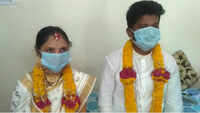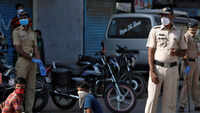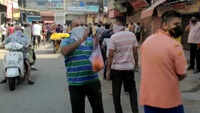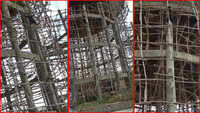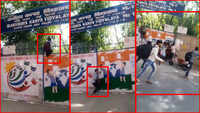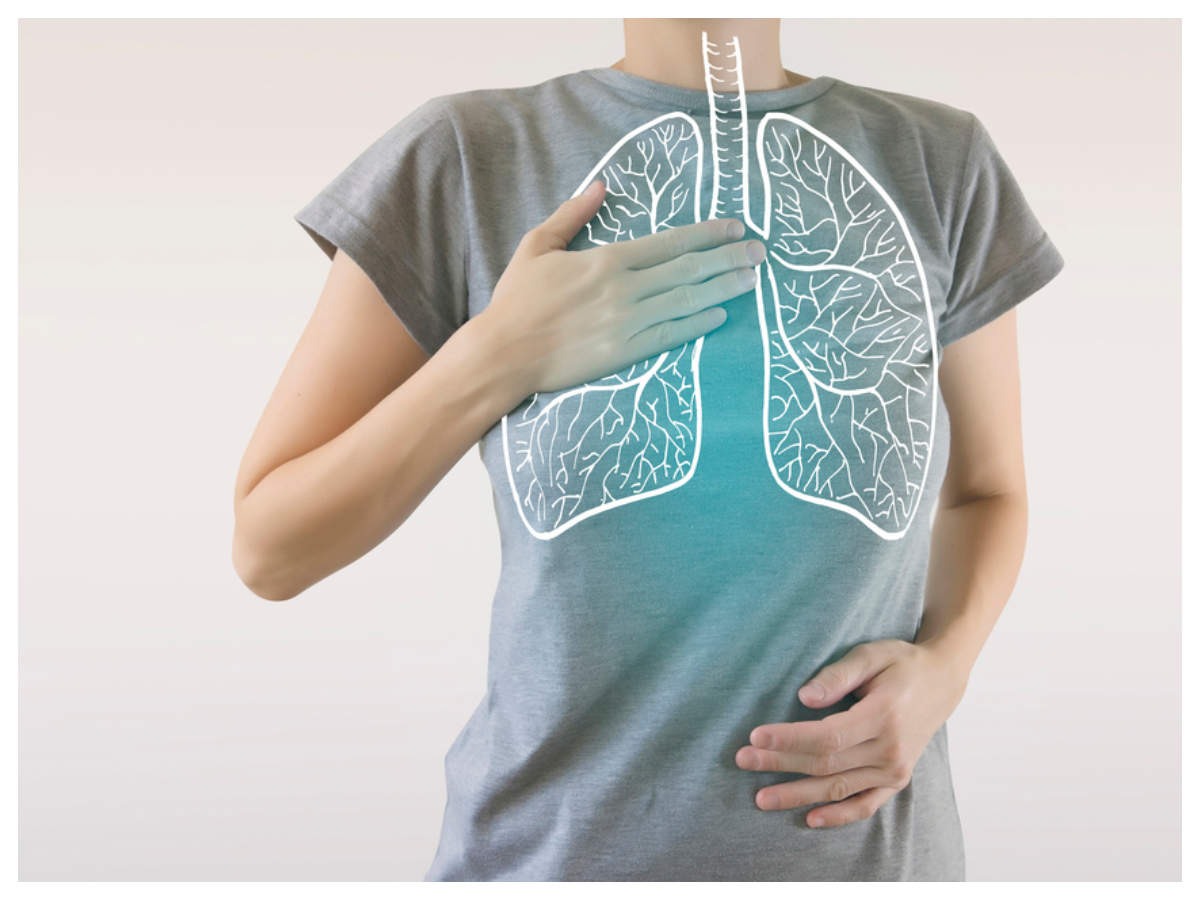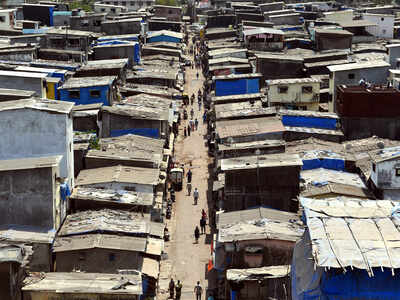
MUMBAI: The sudden discovery of over 50 Covid-19 cases in a slum in Mulund, which had been a low-transmission zone, is an indicator of how rapidly the novel coronavirus can enter and run through the slum pockets of the city, say BMC officials.
Of the 1,927 containment zones marked in the city at the start of the week, 80% were in congested places like slums or chawls. A BMC survey conducted in the last week of April found that 60% of the deaths in the city had occurred in slums and slum-like areas.
As many as 641 of the containment zones were red zones with active outbreaks while 502 were orange zones, where the infection was on the way to getting under control.
Dharavi, one of the red zones, is the worst-hit slum pockets with 632 cases.
An emerging concern is the Mankhurd-to-Shivaji-Nagar belt, an area which is 100% slums, in M-East ward. Of the 460 cases and 51 deaths in M-East, the stretch from Mankhurd to Shivaji Nagar accounts for 60% of the cases.
Local corporator Rukhsana Siddiqui said social distancing was an alien concept in jam-packed localities like Baiganwadi.
"These poor people managed a hand-to-mouth existence. How long can they stay holed up in their 10-by-10 homes? They step out looking for people giving food to feed their hungry children," she said.
Former Tree Authority member Abhijit Chavan, who lives in Mulund, said the emergence of 40 positive cases in the Indira Nagar slum on Monday was an indicator of people's desperation.
"People living here work as house help and are jobless due to the lockdown," he said.
Many had been visiting wholesale markets set up at the Mulund octroi naka to buy vegetables that they could sell to earn some money. "Chances of them bringing the infection was higher and that's what happened," he said.
Slums in posh areas such as Cuffe Parade are no better. Fifty cases were reported from Ganeshmurthi Nagar, Ambedkar Nagar and Geeta Nagar, which jointly have a population of 50,000.
Local corporator Harsita Narwekar said 25 of the cases were from Ganeshmurthi Nagar. One of the index cases there worked in a five-star hotel in the locality.
Narwekar said the bigger problem is inadequate testing. "Those showing only one or two symptoms are not being tested. Their high-risk contacts are thus not being identified or isolated, leading to a spread," Narwekar said.
In the western suburbs, Andheri Juhu Galli, Nehru Nagar and Gilbert Hill saw a sharp spike in cases. In Nehru Nagar, a highly congested cluster with 35,000 population, 76 cases, including five deaths, were reported.
Many of the residents work in plush homes in the JVPD Scheme. As their own homes are small and hot in the summer, many sit outside, said local corporator Renu Hansraj. "People here use community toilets, the biggest source for the spread of infection," she said.
Officials said the percentage of positive cases in slums was rising. "It is passe to expect a Covid-19 patient to be one with a foreign travel history," a BMC official said.
There was a sharp rise in cases in slums in Kurla, Chunnabatti and Saki Naka in 'L' ward, which saw 30 deaths.
A corporator, who did not wish to be identified, said many step out in the evening in the ongoing Ramzan month.
Of the 1,927 containment zones marked in the city at the start of the week, 80% were in congested places like slums or chawls. A BMC survey conducted in the last week of April found that 60% of the deaths in the city had occurred in slums and slum-like areas.
As many as 641 of the containment zones were red zones with active outbreaks while 502 were orange zones, where the infection was on the way to getting under control.
Dharavi, one of the red zones, is the worst-hit slum pockets with 632 cases.
An emerging concern is the Mankhurd-to-Shivaji-Nagar belt, an area which is 100% slums, in M-East ward. Of the 460 cases and 51 deaths in M-East, the stretch from Mankhurd to Shivaji Nagar accounts for 60% of the cases.
Local corporator Rukhsana Siddiqui said social distancing was an alien concept in jam-packed localities like Baiganwadi.
"These poor people managed a hand-to-mouth existence. How long can they stay holed up in their 10-by-10 homes? They step out looking for people giving food to feed their hungry children," she said.
Former Tree Authority member Abhijit Chavan, who lives in Mulund, said the emergence of 40 positive cases in the Indira Nagar slum on Monday was an indicator of people's desperation.
"People living here work as house help and are jobless due to the lockdown," he said.
Many had been visiting wholesale markets set up at the Mulund octroi naka to buy vegetables that they could sell to earn some money. "Chances of them bringing the infection was higher and that's what happened," he said.
Slums in posh areas such as Cuffe Parade are no better. Fifty cases were reported from Ganeshmurthi Nagar, Ambedkar Nagar and Geeta Nagar, which jointly have a population of 50,000.
Local corporator Harsita Narwekar said 25 of the cases were from Ganeshmurthi Nagar. One of the index cases there worked in a five-star hotel in the locality.
Narwekar said the bigger problem is inadequate testing. "Those showing only one or two symptoms are not being tested. Their high-risk contacts are thus not being identified or isolated, leading to a spread," Narwekar said.
In the western suburbs, Andheri Juhu Galli, Nehru Nagar and Gilbert Hill saw a sharp spike in cases. In Nehru Nagar, a highly congested cluster with 35,000 population, 76 cases, including five deaths, were reported.
Many of the residents work in plush homes in the JVPD Scheme. As their own homes are small and hot in the summer, many sit outside, said local corporator Renu Hansraj. "People here use community toilets, the biggest source for the spread of infection," she said.
Officials said the percentage of positive cases in slums was rising. "It is passe to expect a Covid-19 patient to be one with a foreign travel history," a BMC official said.
There was a sharp rise in cases in slums in Kurla, Chunnabatti and Saki Naka in 'L' ward, which saw 30 deaths.
A corporator, who did not wish to be identified, said many step out in the evening in the ongoing Ramzan month.

Coronavirus outbreak
Trending Topics
LATEST VIDEOS
More from TOI
Navbharat Times
Featured Today in Travel
Get the app
